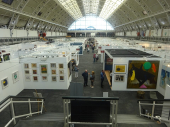Archaeologists in London have begun digging up some 3,000 historic skeletons including those of plague victims from a burial ground that will become a new train station, the company in charge said.
A team of 60 researchers will work in shifts six days a week over the next month at the Bedlam burial ground to remove the centuries-old skeletons, which will eventually be re-buried at a cemetery east of London.
Crossrail, which is building a major new east-west train line in London, said the dig near Liverpool Street station was being carried out on its behalf by the Museum of London's archaeology unit.
The company said in a statement that the bones would be tested to "shed light on migration patterns, diet, lifestyle and demography" of Londoners at the time.
"Archaeologists hope that tests on excavated plague victims will help understand the evolution of the plague bacteria strain," Crossrail added.
The Bedlam ground was used between 1569 and 1738 -- a period that spanned Shakespeare's plays, the Great Fire of London and numerous plague outbreaks.The excavation is also expected to further uncover the remains of an ancient Roman road, where Crossrail said that several artefacts such as horseshoes and cremation urns have already been found.
The area was London's first municipal burial ground and was named after the nearby Bethlem Royal Hospital or "Bedlam" -- the world's oldest psychiatric institution, which became a byword for all mental institutions and has since relocated outside London.
The burial ground was used by Londoners who could not afford a church burial or who chose to be buried there for religious or political reasons.
Members of the Levellers, a 17th-century political grouping that advocated popular sovereignty and religious tolerance, are believed to be buried there.
Following excavation, constructors will build a new ticket hall for Crossrail's Liverpool Street station. "This excavation presents a unique opportunity to understand the lives and deaths of 16th and 17th century Londoners," said Jay Carver, Crossrail's lead archaeologist.
"The Bedlam burial ground spans a fascinating phase of London's history, including the transition from the Tudor-period City into cosmopolitan early-modern London."
Nick Elsden, a project manager from Museum of London Archaeology (MOLA), said: "There are up to six metres of archaeology on site in what is one of the oldest areas of the city, so we stand to learn a great deal".
Crossrail is one of Europe's biggest construction projects and the company said that more than 10,000 artefacts have been uncovered so far in multiple excavations at some 40 sites.
Preliminary excavations at Liverpool Street in 2013 and 2014 uncovered more than 400 skeletons. AFP



































